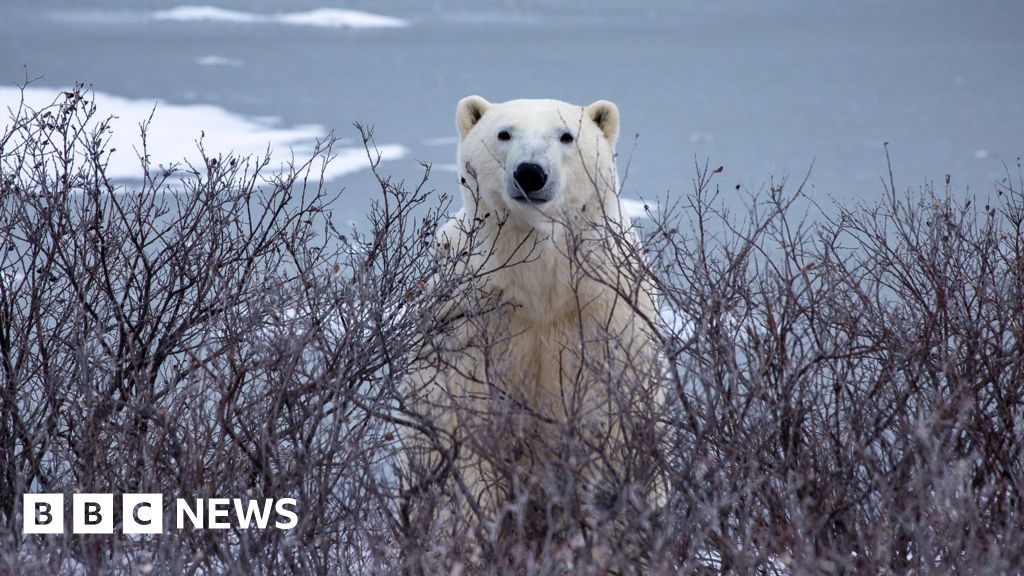“Can I give you some polar bear advice?” asks Tee, a confident 13-year-old we meet on a visit to Churchill High School.
“If there’s a bear that close to you,” she says as she measures a distance of about 12 inches with her hands. “He clenched his fist and punched him in the nose.
“Polar bears have very sensitive noses – they’ll just run away.”
Tee didn’t have to put this advice to the test. But growing up here — along with the planet’s largest land carnivore — means bear safety is part of everyday life.
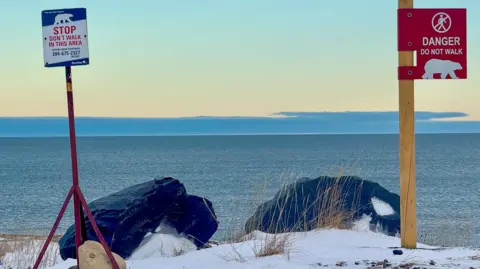 Victoria Gill/BBC
Victoria Gill/BBCSigns – in shops and cafes – remind anyone going out to be “careful”. My favorite reads: “If a polar bear attacks you, you should I fight back.”
Running away from a charging polar bear is – perhaps counterintuitively – dangerous. A bear’s instinct is to chase prey and polar bears can run at 40 km/h.
Key tip: Be alert and aware of your surroundings. Don’t walk alone at night.
 Victoria Gill/BBC
Victoria Gill/BBCChurchill is known as the polar bear capital of the world. Every year, Hudson Bay – on the western edge of which the city sits – thaws and forces the bears ashore. As the cold sets in in the fall, hundreds of bears gather here and wait.
“We have freshwater rivers flowing into the area and cold water coming from the Arctic,” explains Alyssa McCall of Polar Bears International (PBI). “So the freezing happens here first.
“For polar bears, sea ice is a big dinner plate – it’s access to their main prey, seals. They’re probably excited by a hearty meal of seal blubber – they haven’t eaten much all summer on land.’
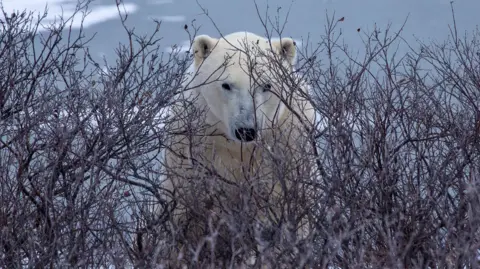 Victoria Gill/BBC
Victoria Gill/BBCThere are 20 known subpopulations of polar bears in the Arctic. It is one of the southernmost and best studied.
“They’re our fat, white, hairy canaries in the coal mine,” explains Alyssa. “We had about 1,200 polar bears here in the 1980s and we lost almost half of them.”
The decline is related to the time the gulf is already ice-free, a period that is getting longer as the climate warms. No sea ice means no frozen platform for seal hunting.
“The bears here are now on land about a month longer than their grandparents were,” explains Alyssa. “It puts pressure on the mothers. (With less food) it’s harder to get pregnant and support those babies.”
Although their long-term survival is uncertain, the bears attract conservationists and thousands of tourists to Churchill each year.
We tag along with a group from PBI to look for bears in the sub arctic tundra – just a few miles from town. The team travels in a tundra buggy, a type of off-road bus with huge tires.
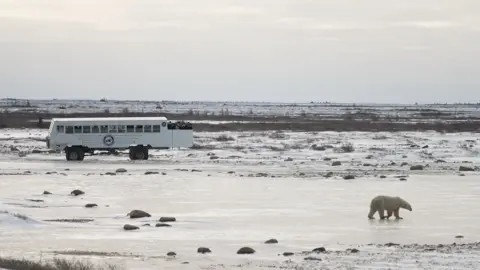 Kevin Church/BBC
Kevin Church/BBCAfter a few distant sightings, we have a heart-stopping close encounter. A young bear approaches and surveys our slow convoy of two buggies. He stands to the side, sniffs one of the vehicles, then jumps up and places two giant paws on the side of the buggy.
The bear casually slumps back onto all fours, then looks up and looks at me briefly. It is deeply confusing to look into the face of an animal that is both adorable and potentially deadly.
“You could see him sniffing and even licking the vehicle — using all his senses to investigate,” said PBI’s Jeff York, who has worked in the Arctic for more than three decades.
 Kevin Church/BBC
Kevin Church/BBCBeing here in “bear season” means Jeff and his colleagues can test new technologies to detect bears and protect people. The PBI team is currently fine-tuning a radar-based system called “bear-dar.”
The experimental platform – a tall antenna with detectors scanning 360 degrees – is installed on the roof of a hut in the middle of the tundra, near Churchill.
“He has artificial intelligence, so here we can teach him what a polar bear is,” Jeff explains. “This works 24/7, sees at night and in poor visibility.”
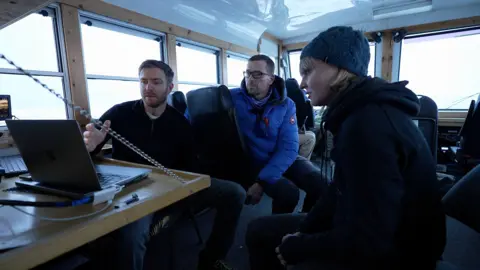 Kevin Church/BBC
Kevin Church/BBC Annie Edwards
Annie EdwardsProtecting the community is the job of the Polar Bear Alert Team – trained rangers who patrol Churchill every day.
We ride along with ranger Ian Van Nest, who is looking for a stubborn bear that he and his colleagues tried to drive off earlier that day. “He turned and went back (to) Churchill. He doesn’t seem interested in leaving.”
For bears that intend to hang around town, the team can use a live trap: a tube-shaped container fed with seal meat, with a door that the bear activates when it climbs inside.
“Then we put them in the holding facility,” explains Ian. The bears are kept for 30 days, a period designed to teach the bear that it is a negative thing to come to town to look for food, but this does not put the animal’s health at risk.
They are then moved – either on the back of a trailer or occasionally lifted by helicopter – and released further along the bay, away from humans.
 Victoria Gill/BBC
Victoria Gill/BBCCyril Fredlund, who works at the new Churchill Science Observatory, remembers the last time a person was killed by a polar bear in Churchill in 1983.
“It was right in the city,” he says. “The man was homeless and was in an abandoned building at night. There was also a young bear there – he took it down with his paw as if it were a seal.’
People came to help, Cyril recalls, but they were unable to get the bear away from the man. “Like he was guarding his food.”
 Victoria Gill/BBC
Victoria Gill/BBCThe Polar Bear Alert Program was established at this time. Since then, no one has been killed by a polar bear here.
Cyril is now a technician at the new Churchill Marine Observatory (CMO). Part of his mission is to understand exactly how this environment will respond to climate change.
Under the retractable roof are two giant pools filled with water pumped directly from Hudson Bay.
 Victoria Gill/BBC
Victoria Gill/BBC“We can do all kinds of controlled experimental studies to investigate changes in the Arctic,” says Prof. Feiue Wang.
One consequence of a less icy Hudson Bay is a longer operating season for the port, which is currently closed for nine months of the year. A longer season in which the bay thaws and becomes open water could mean more ships entering and exiting Churchill.
Studies at the observatory aim to improve the accuracy of sea ice forecasting. The research will also examine the risks associated with port expansion. One of the first studies was an experimental oil spill. The scientists plan to drop oil into one of the pools, test cleanup techniques and measure how quickly the oil breaks down in the cold water.
For Churchill Mayor Mike Spence, understanding how to plan for the future, especially when it comes to getting goods to and from Churchill, is vital to the city’s future in a warming world.
“We’re already considering extending the season,” he says, pointing to the port, which has shut down for the winter. “Ten years from now, this will be alive.”
 Victoria Gill/BBC
Victoria Gill/BBCClimate change poses a challenge to the polar bear capital of the world, but the mayor is optimistic. “We have a great city,” he says, “a wonderful community. And the summer season – (when people come to see Beluga whales in the bay) – is growing.”
“We all face challenges from climate change,” he adds. “Does that mean you cease to exist? No – you adapt. You figure out how to take advantage of it.”
While Mike Spence says “the future is bright” for Churchill, it may not be so bright for polar bears.
You and her friends look out over the bay from a window at the back of the school building. Polar Bear Alert Team vehicles gather outside, trying to move a bear away from the city.
“If climate change continues,” reasons Charlie, Tee’s classmate, “the polar bears might just stop coming here.”
The teacher walks over to make sure someone is coming to get the kids – that they aren’t going home alone. All this is part of everyday life in the polar bear capital of the world.
 Kate Stevens/BBC
Kate Stevens/BBC
https://ichef.bbci.co.uk/news/1024/branded_news/60d5/live/75afe800-bc76-11ef-a2ca-e99d0c9a24e3.jpg
2024-12-18 00:36:49

